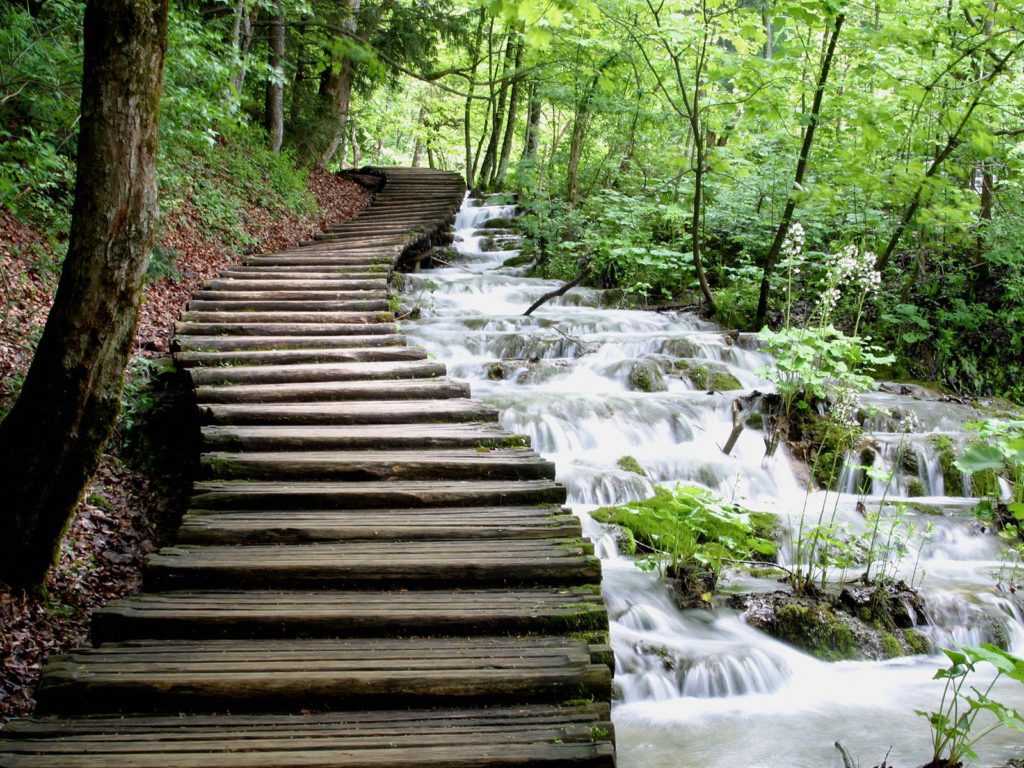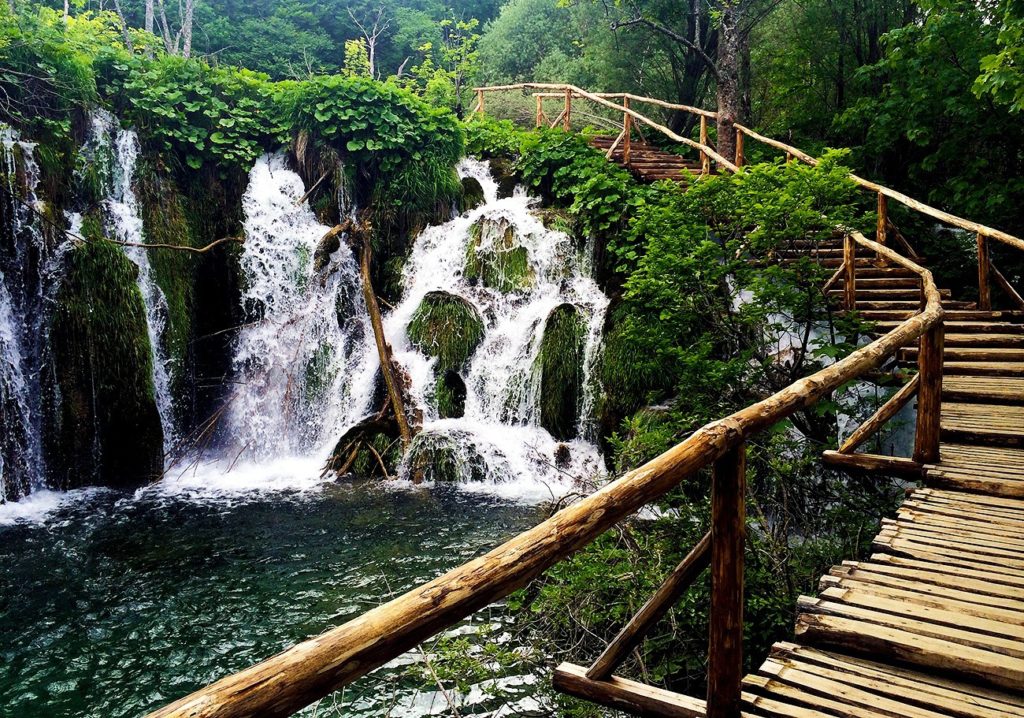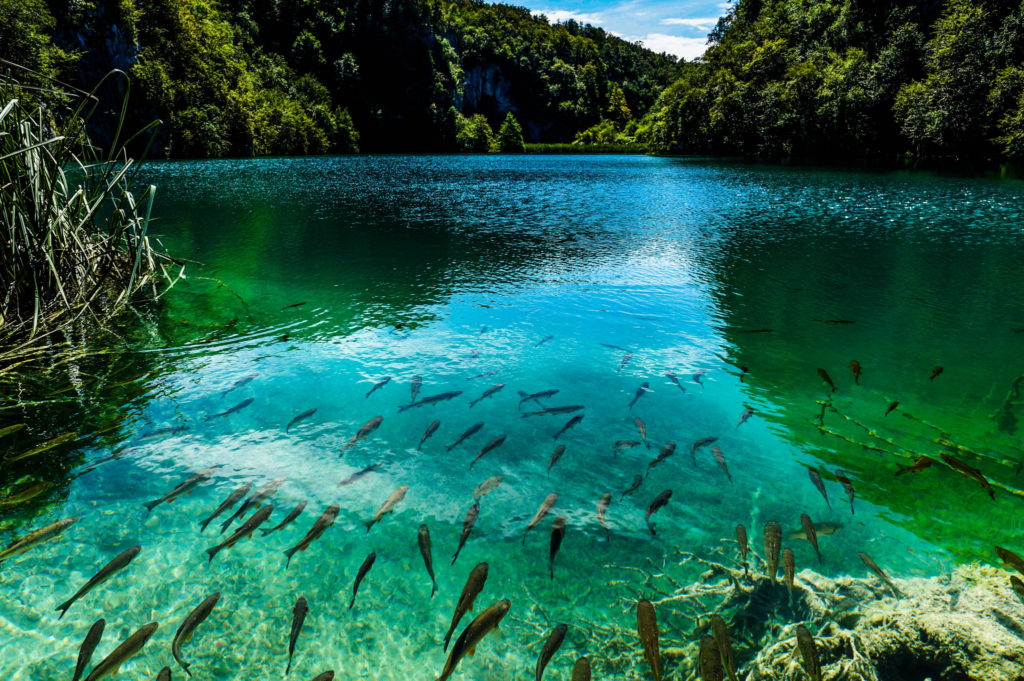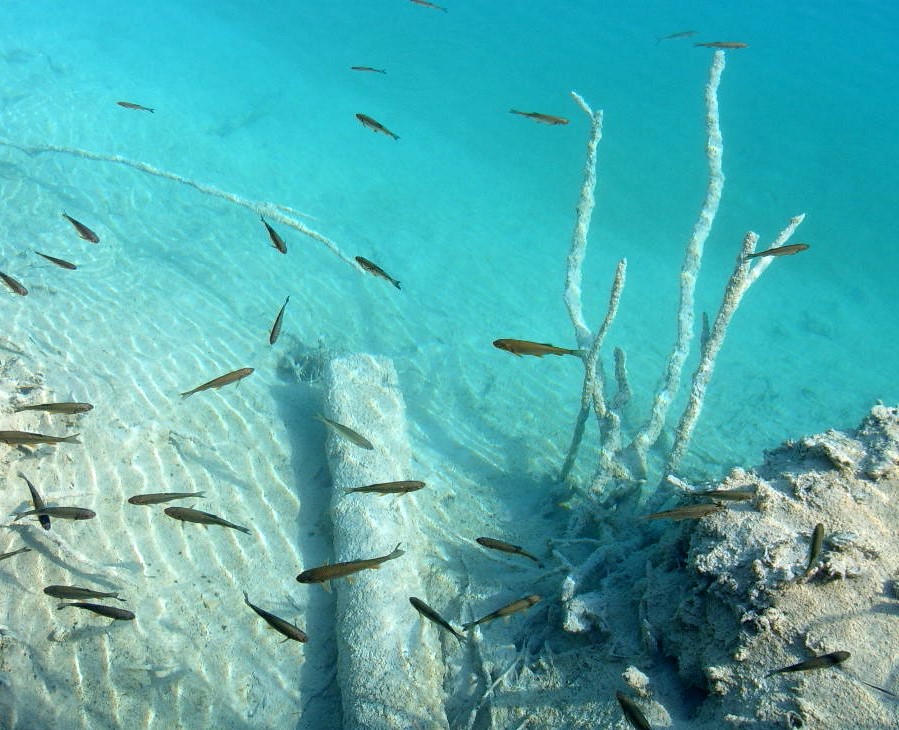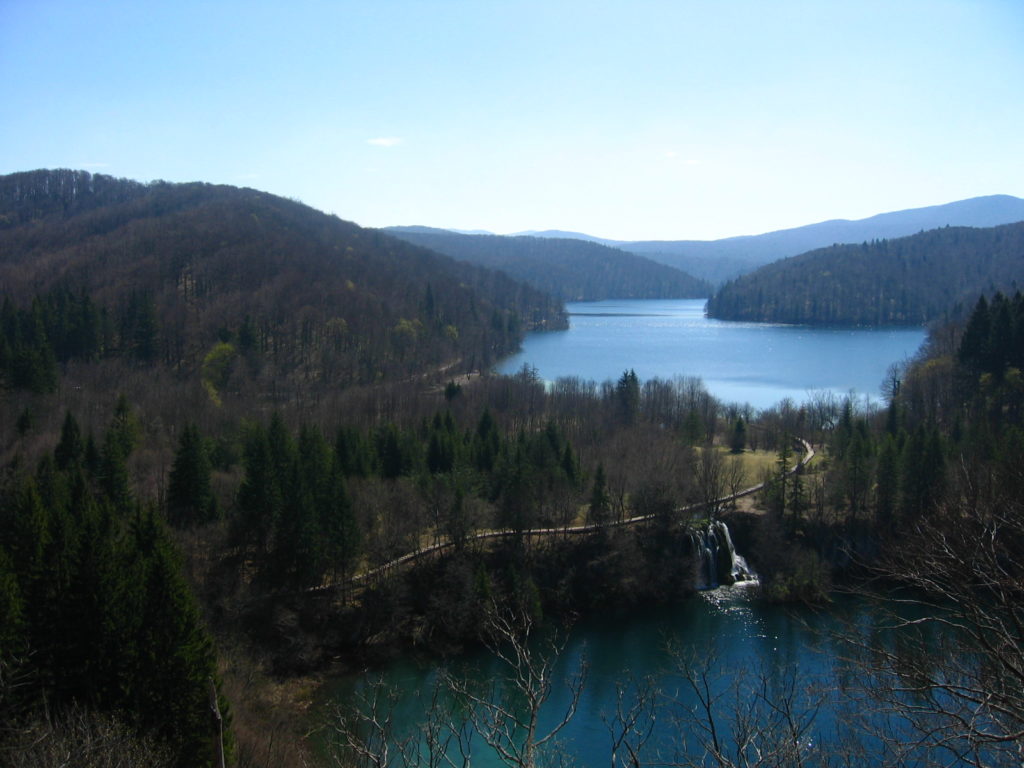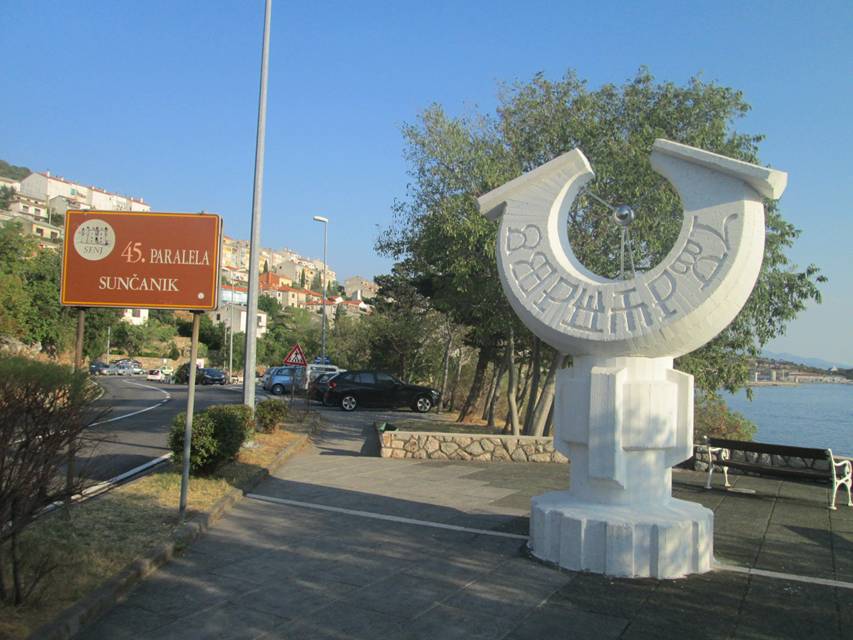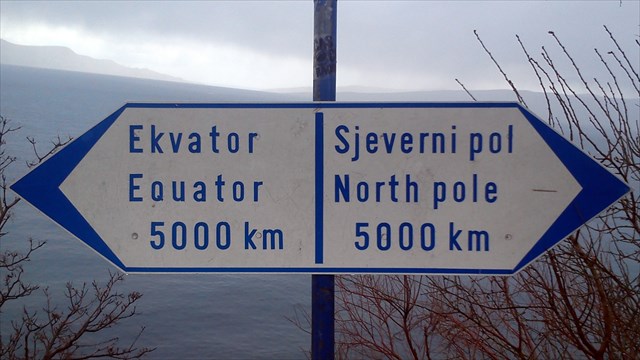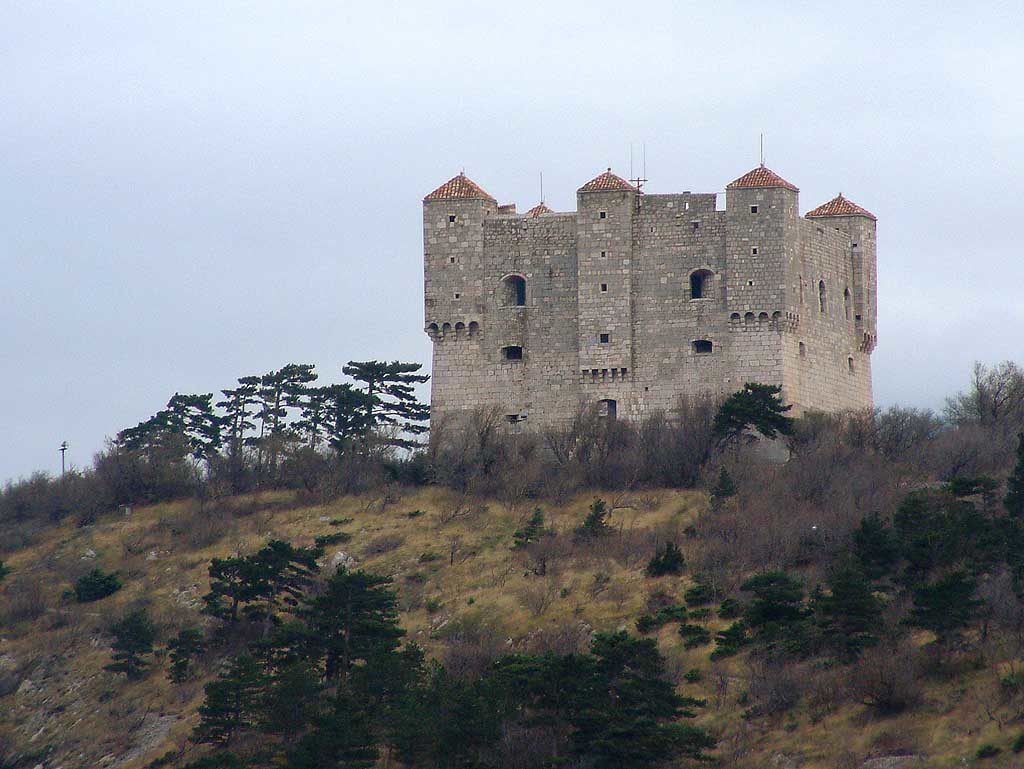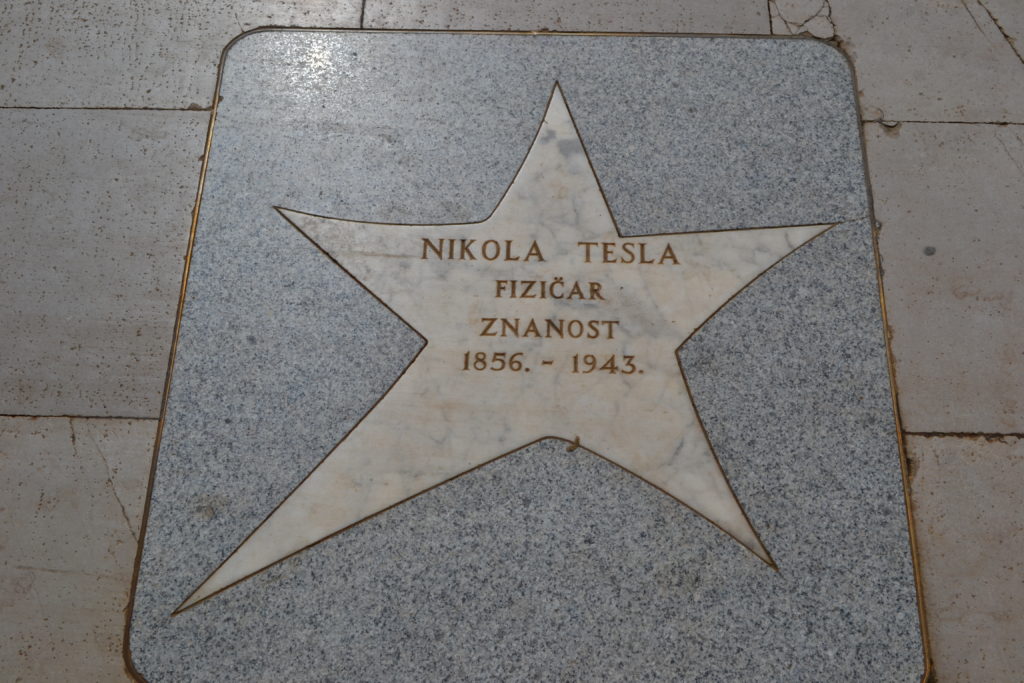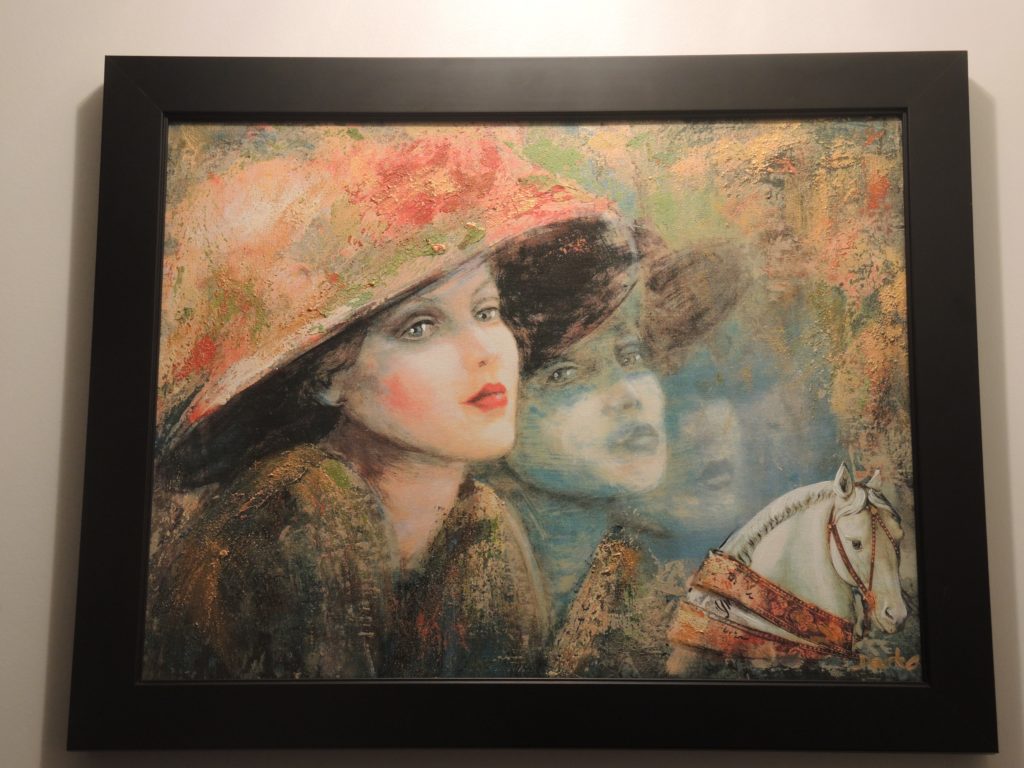When I left you in the previous post, we were about to set off on a five-kilometer circuit of the upper lakes at Plitvice. Although the walk isn’t particularly strenuous, the unevenly slatted boardwalk on which you spend most of your time (with the rest on unpaved dirt paths) requires some care and attention to traverse. Often, you come close to actually walking on the pristine unsullied water with no rails to protect you. Like this
or this
Where there are railings, the path is often steeper.
The lakes are fed principally by two rivers. The Bijela Rijeka or White River and the Crna Rijeka which I hope you remember from Crna Gorda (Black Mountain/Montenegro) would translate as Black River. Adding to these principal flows are numerous karst rivers.
(Karst rivers, which we’ll learn more about when we reach Slovenia, flow through porous rock such as limestone, dolomite, and gypsum and it’s the former two types of rock that predominate in Plitvice. The rivers often disappear into underground drainage systems creating sinkholes and caves before reappearing above ground where it is typically assumed to be a different river.)
Before I post some additional photos, I should note that while the walk was stunning, our brief stay didn’t allow us to explore the park in depth and, as you can imagine, in a 300 square kilometer park, there would be much to explore particularly since 75 percent of the park is forest. Here are some other facts about the park:
Plitvice is said to be the home of 50 species of mammals including relatively large populations of brown bears and wolves as well as many species of bats. Birders have the chance to spot 157 different species. Or you can simply marvel at the lakes.
The park’s forestation consists mainly of beech, spruce and fir trees and, in the northwest section of the park called Čorkova uvala (Čorkova bay), some of the trees are estimated to be 700 years old. The park also houses 55 species of orchids. Or you can simply marvel at the lakes.
Now back to the photos of the lakes which are the park’s signature feature.
(I tried to download photos that approximated some of my experience. I didn’t get any of the broad panoramic views you’ll see but they’re so spectacular I felt they deserved inclusion.)
Yes, the water is this clear:
And from above you might see scenes like these:
Finally, I’ll leave you with this:
Returning to the coast
After finishing our walk around the lakes, we boarded the bus and began the two-hour journey back toward the coast and the Istrian Peninsula. The day’s end point is the seaside town of Opatija on the northwestern corner of the peninsula. On the way, we’d stop briefly in the coastal town of Senj where we’d return to the Jadranska Magistrala which we’d traversed from Dubrovnik to Kotor, Montenegro and then north through Neum on our way to Mostar. We’d follow that road north along the part of the Adriatic known as the Kvarner Gulf, through Croatia’s third largest city, the port city of Rijeka before ending the drive on Opatija just on the opposite side of the gulf’s ‘v’ from Rijeka.
Though our stop in Senj was very brief, Damir explained something about the Croatian coast to us that was new information to me. Senj is about a third of the way between Rijeka and Zadar and the Croatians refer to this part of their country as Kvarner. The Dalmatian coast is the stretch between Zadar and the northern border with Bosnia and Herzegovina and the final bit between the southern border with B&H and the border with Montenegro that includes Dubrovnik is called the Croatian Riviera. (I did find that other beach areas such as Opatija in Croatia also use the term Riviera.)
When we stopped in Senj, we were at the midpoint of the northern hemisphere – a fact celebrated by the sign and sundial
Had we extended our stop in Senj for an hour or two we might have learned that the area was settled by Illyrian tribes at least as early as the fourth century BCE when a Greek document mentions a settlement at the site called Attienities. The Catholic Church established a diocese there in 1169 and the Hungarian King Béla III gave the town to the Knights Templar in 1184.
From a distance we saw the Nehaj Fortress (also called the Tower of Senj according to my log of lost photos). It was completed in 1558 and was occupied by the Uskoks who fought a guerilla style naval war against the Ottoman Turks.
Today, the fortress is a main symbol of the town.
We had a relaxing ride along the coast as Damir went largely silent (I have no audio archive) and our driver, Darko, guided the bus gently toward Istria. I think I must have dozed off because I took only two photos (and lost them with my camera in Budapest) between Senj and Opatija and none of Rijeka.
Opatija offers at least one bit of intriguing history – it’s called the first resort in Croatia – and some sources consider it the spot that began Croatian tourism. Here’s how that happened: In 1844, a wealthy merchant from Rijeka named Iginio Scarpa built his holiday home that he called Villa Angiolina in Opatija. He began inviting businessmen and politicians to vacation with him and some of them became interested in developing the town.
The process was slow but eventually, Friederich Schuler, the director of the Austrian Southern Railway Company, saw some potential profits to be made and invested heavily in Opatija. In 1884, he built the town’s first hotel – complete with an indoor sea water pool – that still operates today as the Hotel Kvarner.
Just five years later, Opatija was officially declared a health resort. Still under the rule of the Austro-Hungarian Empire, this declaration prompted a number of prominent physicians to open sanatoriums there and soon, the rich and famous began to visit. Among them are said to have been Emperor Franz Joseph, James Joyce, Vladimir Nabokov, Gustav Mahler, and Isadora Duncan. We saw none of them during our brief stay.
As I recall, we ate dinner at an outdoor restaurant on the water some steps down from our hotel. After dinner we were able to wander about a bit starting on the Lungomare – an eight-or nine-kilometer-long path along the water that begins in Voloska about three kilometers east of Opatija. It passes through Opatija to Icici beach before ending in Lovran whence, I was told, one can experience excellent views of the islands of Krk and Cres.
In Copenhagen, visitors flock to see the Little Mermaid. Visitors to Opatija who walk along the Lungomare will encounter the Maiden with the Seagull.
 (In Pat’s picture, the seagull on her arm is part of the sculpture. The one on her head is not.)
(In Pat’s picture, the seagull on her arm is part of the sculpture. The one on her head is not.)
Her story begins in 1891 with when Count Arthur Kesselstadt and his wife drowned in a storm just off the coast. The family installed a sculpture of the Madonna on the rock to honor their memory. Over time, the Madonna statue succumbed to weather damage and had to be removed. It was eventually restored and is on display in the Croatian Museum of Tourism in the Villa Angiolina.
The new statue, which is the work of Croatian sculptor Zvonko Car, was installed in 1956. There’s no fairy tale or additional tragedy to go along with this statue that the locals call the Nymph because when the waves splash over the reef and, as the sea sprays and scatters, the young girl in her modest windblown shift gives the appearance of a nymph rising from the sea.
Further along the Ulica Maršala Tita (Tito Street), Opatija held another surprise. Just behind Slatina – the beach in the center of town – and a small army of pushcarts that mainly sell food and souvenirs is the
It consists of 32 marble stars with names of prominent Croatian athletes, scientists and artists. Here’s the star of Croatia’s most famous native son:
In some ways, I’m a lousy tourist. I’ve reached an age when I refrain from buying much in the way of souvenirs and memorabilia. I will buy some small gifts for friends and family but I purchase almost nothing for myself. Here’s the complete inventory of my personal travel swag:
A (“Made in China”) paper hat I bought in Dubrovnik
A hat I bought in Mostar
A t-shirt from the Sarajevo Film Festival
And from Opatija, I brought home:
Next up, we visit the hill towns of Istria.

